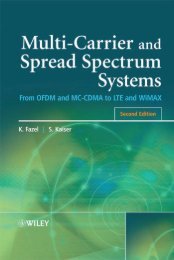Dirty Paper Coding using Sign-bit Shaping and LDPC Codes
Dirty Paper Coding using Sign-bit Shaping and LDPC Codes
Dirty Paper Coding using Sign-bit Shaping and LDPC Codes
You also want an ePaper? Increase the reach of your titles
YUMPU automatically turns print PDFs into web optimized ePapers that Google loves.
ISIT 2010, Austin, Texas, U.S.A., June 13 - 18, 20101000 100110111010111011111101110000000001001100100110011101010100-15/2 -13/2 -11/2-9/2-7/2-5/2-3/2-1/21/23/25/27/29/211/213/215/2Fig. 1.16-PAM constellation.n − sParity plus MessageBitsk ′MessageBits✲H −1Ts = nlog2MBits✲❄<strong>Shaping</strong> CoderViterbiAlgorithmminimizes theenergy of(v − αS) mod MsShapedBits✲<strong>LDPC</strong>Encoderof rate(k − k ′ + s) /n✲ Delay ✲n − (k − k ′ + s)ParityBits✲k − k ′Message <strong>bit</strong>s∏✲a b cMappingtoM − PAMmap (zabc)v−αS✓✏ ❄✲ ∑✒✑❄mod M✲(k − k ′ )MessageBits✻sShaped Bitsz❄(v − αS) mod MFig. 2.Encoder structure.<strong>and</strong> p T −1 are rearranged by a permutation Π to form thevectors a j , 2 ≤ j ≤ l. This permutation is necessary in animplementation of BICM [11].Note that both the shaping <strong>and</strong> coding objectives havebeen met at the encoder. The transmitted symbols v − αSmod M have minimal energy in the lattice defined by sign<strong>bit</strong>shaping <strong>using</strong> the convolutional code. Selected <strong>bit</strong>s insuccessive blocks of symbols form codewords of the <strong>LDPC</strong>code. In summary, the encoder structure achieves DPC shaping<strong>and</strong> <strong>LDPC</strong> coding with <strong>bit</strong>-interleaved modulation.B. Decoder StructureThe decoder for the proposed scheme is as shown in Fig.3.Because of the one-codeword delay, parity <strong>bit</strong>s of the T +1-th block <strong>and</strong> message plus shaped <strong>bit</strong>s of the T -th blockform a valid <strong>LDPC</strong> codeword. Therefore, an <strong>LDPC</strong> decoderis first run on these symbols corresponding to a codeword. Thedecoded shaped <strong>bit</strong>s are passed through a syndrome former toget message <strong>bit</strong>s used for shaping. Iterations between shapingdecoder <strong>and</strong> channel decoder are not needed. The demappercomputes log likelihood ratios (LLRs) for the <strong>bit</strong>s from thereceived symbols in Ŷ = αY + U. The LLRs of the (k − k′ )message <strong>bit</strong>s after a delay of one time step, <strong>and</strong> the LLRs of then−(k − k ′ + s) parity <strong>bit</strong>s are de-interleaved. The s =nlog 2MLLRs of the sign <strong>bit</strong>s after a delay on one time step, <strong>and</strong> then−s output LLRs of the de-interleaver are given as the input tothe <strong>LDPC</strong> decoder. The <strong>LDPC</strong> decoder outputs k−k ′ message<strong>bit</strong>s <strong>and</strong> s <strong>bit</strong>s of the sign <strong>bit</strong> vector of the previous block. Now,the s-<strong>bit</strong> sign vector is passed through the syndrome formerto recover the remaining k ′ message <strong>bit</strong>s.The demapper function at the receiver has to calculate LLRstaking into account the modulo M operation at the encoder [4].Therefore, the received constellation A R is a replicated versionof the M-PAM constellation A used at the transmitter (assumingthat scaling factors have been corrected at the receiver).That is, A R = {A−rM, ··· ,A−M, A, A+M,··· ,A+rM}.The number of replications r is chosen so that the averagepower of A R is approximately equal to the total averagepower P X + P S , <strong>and</strong> the <strong>bit</strong> mapping of the symbol a + jM(a ∈ A, 1 ≤ j ≤ r) is the same as that for a. The LLR forthe i-th <strong>bit</strong> in the j-th symbol Ŷj is computed according tothe constellation A R <strong>using</strong> the following formula:⎛2⎞∑(Ŷj⎜exp ⎝− 1 − a)⎟⎠2 αP NL i =a∈A R:<strong>bit</strong> i=0∑a∈A R:<strong>bit</strong> i=1⎛⎜exp ⎝− 1 22⎞.(Ŷj − a)αP N⎟⎠925
















